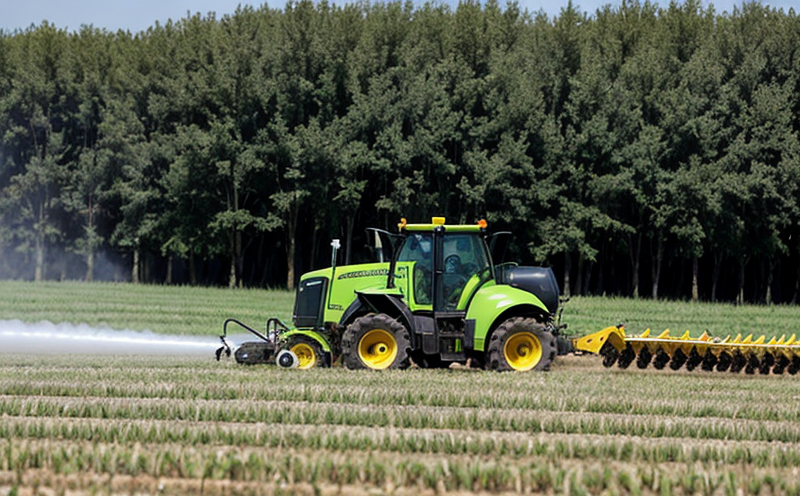Difenoconazole Residue Testing in Crops
The active ingredient difenoconazole is a broad-spectrum fungicide widely used to protect crops against fungal diseases. The demand for precision and accuracy in residue testing has increased significantly, especially as regulatory standards evolve. This service ensures compliance with international regulations such as ISO 15032-1 and EU MRLs (Maximum Residue Limits).
Difenoconazole is primarily used on crops like wheat, barley, oats, and corn to control fungal pathogens that can reduce yield and quality. Accurate residue testing is crucial for maintaining product integrity and ensuring consumer safety.
Our laboratory employs advanced analytical techniques such as Liquid Chromatography-Mass Spectrometry (LC-MS/MS) to identify and quantify difenoconazole residues in crops. This method allows us to detect even trace amounts of the fungicide, providing reliable data for your quality control processes.
The testing process involves several steps:
- Sampling: Samples are collected from various parts of the crop field to ensure a representative sample.
- Sample Preparation: The samples undergo extraction and clean-up procedures to isolate difenoconazole residues.
- Analytical Analysis: Using LC-MS/MS, we analyze the extracted material for difenoconazole presence and concentration levels.
The results are reported in parts per million (ppm) or parts per billion (ppb), which align with regulatory standards. This data helps your quality management team make informed decisions about product safety and compliance.
By offering difenoconazole residue testing, we support the agricultural sector's drive towards sustainable farming practices. Our service ensures that crops meet stringent MRLs set by regulatory bodies worldwide, thereby safeguarding both consumer health and market access.
Scope and Methodology
| Sample Type | Tested Crops | Methodology | Regulatory Compliance |
|---|---|---|---|
| Cereal Grains (Wheat, Barley, Oats) | Difenoconazole Residues | LC-MS/MS Analysis | ISO 15032-1; EU MRLs |
| Maize (Corn) | Difenoconazole Residues | LC-MS/MS Analysis | ISO 15032-1; EU MRLs |
The table above outlines the scope of our testing service, covering cereal grains and maize. We use Liquid Chromatography-Mass Spectrometry (LC-MS/MS) to ensure precision and accuracy in detecting difenoconazole residues. Our methodology adheres strictly to international standards such as ISO 15032-1 and EU MRLs.
The testing process begins with sample collection from fields where difenoconazole has been applied. Once collected, the samples are processed through extraction methods designed to isolate difenoconazole residues effectively. The extracted material is then analyzed using LC-MS/MS to determine the presence and concentration of the fungicide. This analytical approach ensures that we achieve accurate results every time.
The regulatory compliance aspect of our service is critical for ensuring your products meet global standards. By adhering to ISO 15032-1 and EU MRLs, you can be confident that any residues detected are within permissible limits, thereby protecting both your reputation and market access.
Customer Impact and Satisfaction
Our customers benefit significantly from our difenoconazole residue testing service. By providing accurate and reliable data on crop residues, we empower quality managers and compliance officers to make informed decisions regarding product safety and regulatory compliance.
R&D engineers can use the results of these tests to refine their fungicide application techniques, optimizing yield while minimizing environmental impact. Procurement teams also gain valuable insights into supply chain integrity, ensuring that only compliant products enter their processes.
Customer satisfaction is a key priority for us. We strive to provide timely reports and actionable insights that help our clients meet regulatory requirements efficiently. Our team of experts ensures that all samples are handled with care, from initial collection through final analysis.
Feedback from satisfied customers highlights the importance of this service in maintaining product integrity and ensuring compliance with international standards. By leveraging our expertise, you can trust that your crops will always meet stringent residue limits, protecting both consumer health and market access.
Environmental and Sustainability Contributions
Difenoconazole residue testing plays a crucial role in promoting sustainable agricultural practices. By ensuring that crop residues comply with regulatory standards, we contribute to environmental protection and public health.
The accurate detection of difenoconazole helps reduce the risk of overuse or misuse, which can lead to soil contamination and adverse effects on non-target organisms. This contributes positively to biodiversity conservation efforts within agricultural ecosystems.
Furthermore, by adhering to international standards like ISO 15032-1 and EU MRLs, we support the development of safer farming practices that enhance long-term sustainability. Our service not only benefits individual farms but also contributes to broader environmental goals set forth by global organizations.
In conclusion, difenoconazole residue testing is an essential tool for maintaining agricultural sustainability. Through precise detection methods and compliance with international standards, we help protect the environment while ensuring product safety and regulatory adherence.





